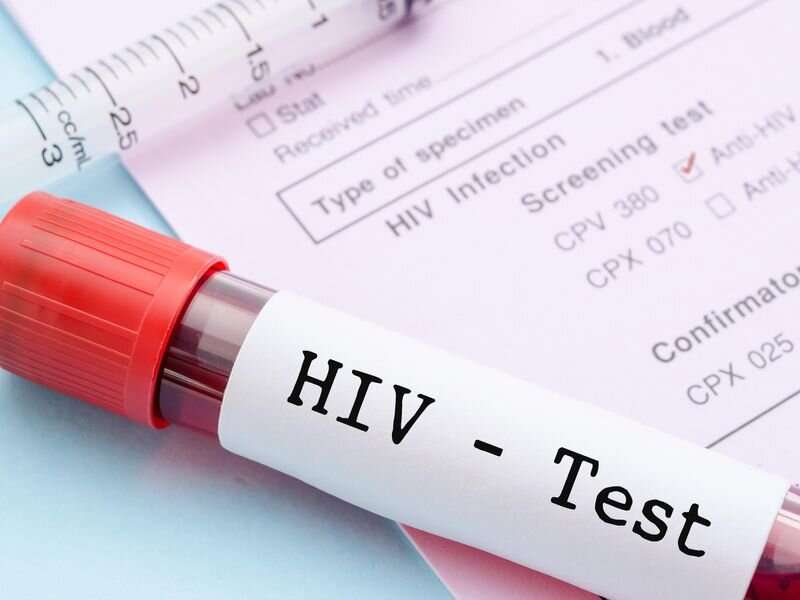This article has been reviewed according to Science X's editorial process and policies. Editors have highlighted the following attributes while ensuring the content's credibility:
fact-checked
peer-reviewed publication
reputable news agency
proofread
10 years on, stem cell transplant may have cured a patient of HIV

A man who underwent a stem cell transplant to treat his cancer is showing "strong evidence" that the procedure also cured him of HIV—the latest in a handful of cases doctors have reported.
The patient, a man in his 50s, was HIV-positive when he underwent a stem cell transplant to treat leukemia. The procedure effectively gave him a new immune system—critically, from a donor who had a rare gene mutation that makes body cells resistant to HIV infection.
That was a decade ago. Now, researchers are reporting, the patient has been off HIV medications for four years, with no signs that the virus remains in his body.
Experts were cautious about declaring it a definite cure, as HIV is a foe with many tricks in its quest to survive.
At the same time, things look promising, according to Dr. Björn Jensen, division head of infectious diseases at Dusseldorf University Hospital in Germany.
The patient has been off of all anti-viral medication for four years, and even with the "most elaborate scientific methods," Jensen said, his team has found no evidence of HIV in his body.
"Most experts would consider this situation a cure," he said.
The man, known as the "Dusseldorf patient," represents the third such case reported in the medical literature. The first was described nearly 15 years ago in the New England Journal of Medicine, when doctors detailed the case of the "Berlin patient." Over a decade later, another medical team reported what they believed was a second HIV cure—in a person dubbed the "London patient."
Both of those patients later went public: An American, Timothy Ray Brown, was the Berlin patient, and in 2020, Adam Castillejo, a British-Venezuelan man, came forward as the London patient. (Two additional cases of long-term HIV remission after a stem cell transplant have been reported at medical meetings, but not yet published in medical journals, Jensen noted.)
All three men needed a stem cell transplant because they had blood cancer and had exhausted their other treatment options. But there was also a secondary possibility: The transplant might battle their HIV, too.
That's because their doctors were able to find compatible donors whose stem cells had a rare, fortuitous characteristic: They carried two copies of a particular mutation in a gene called CCR5—one that deletes the receptors that most HIV strains use to infect cells.
After the Dusseldorf patient received his transplant, in February 2013, levels of "pro-viral" HIV in his blood became undetectable. And over time, other highly sensitive tests failed to detect signals of the virus in the patient's blood cells and tissues. In November 2018, he agreed to stop his HIV medications, to see whether there would be any viral rebound.
Over four years later, there has been no such rebound, Jensen's team reported in the Feb. 20 issue of Nature Medicine.
No one is proposing that stem cell transplantation become an HIV treatment. It's a risky procedure that can have deadly complications, and should only be done when a patient has "life-threatening" blood cancer, Jensen stressed.
But, he said, "we are hopeful that the findings from this and the other few cases of HIV cure will support future research to develop less risky and more widely applicable strategies for curing HIV."
Dr. David Margolis directs the HIV Cure Center at the University of North Carolina at Chapel Hill and is a fellow of the Infectious Diseases Society of America. He said that some researchers are pursuing the idea of using CRISPR technology to "edit" the CCR5 gene as an HIV treatment—though there are "a lot of challenges" to doing so.
This latest case, Margolis said, could be seen as support for research into therapies that target CCR5.
But he also said there are still questions as to exactly how the stem cell transplants worked in these patients. "Something wiped out the HIV," Margolis said, but it's not clear what that was.
Stem cell transplants involve high-dose chemotherapy, for example, and there could be a role for that, Margolis said. In addition, several of the five patients reported on so far developed graft-versus-host disease after their transplant; that means their new immune system saw the body as "foreign" and attacked.
It's possible, Margolis said, that played a role in wiping out their HIV.
More information: Björn-Erik Ole Jensen, In-depth virological and immunological characterization of HIV-1 cure after CCR5Δ32/Δ32 allogeneic hematopoietic stem cell transplantation, Nature Medicine (2023). DOI: 10.1038/s41591-023-02213-x. www.nature.com/articles/s41591-023-02213-x
The U.S. National Institute of Allergy and Infectious Diseases has more on HIV treatment.
Copyright © 2023 HealthDay. All rights reserved.





















